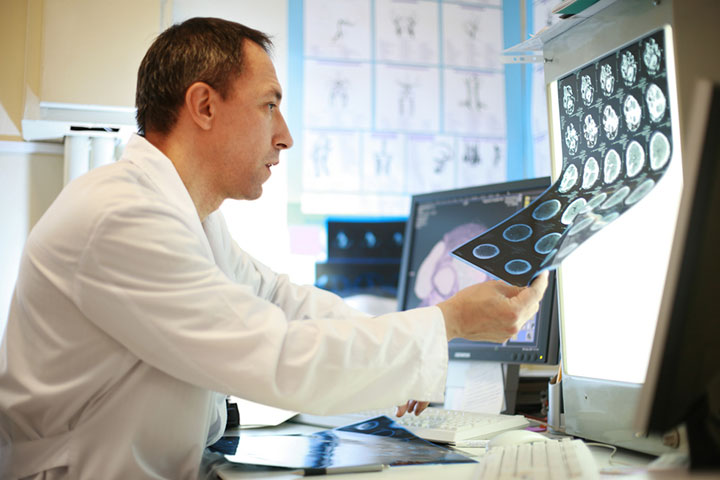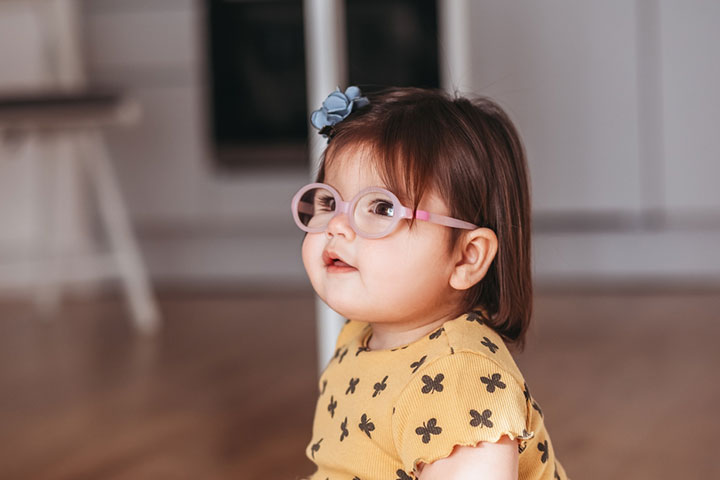Congenital nystagmus, or nystagmus in babies, affects about one in every 5,000 live births and usually appears between the ages of six weeks and six months. Nystagmus is an oculariXA term used to describe something related to the eyes or their function. condition wherein the eyes exhibit recurrent, unpredictable movements, and random eye jerking. During visual development, your baby’s eyes will wander around to follow objects, voices, or people around them. However, nystagmus causes neonates to have more frequent and consistent eye movements than normal, which can be multi-directional, including horizontal, vertical, and torsional (1).
Nystagmus can be caused by various medical disorders and may be linked to vision impairment or impaired eyesight in many babies. Read on to know the causes, symptoms, risk factors, diagnosis, and treatments for nystagmus in babies.
Types Of Nystagmus In Babies
Nystagmus in babies is called infantile nystagmus, and it can be classified into the following two types (2).
1. Congenital nystagmus
Congenital nystagmus is present at birth or occurs within the first six months of life. This can be further classified into two types.
- Congenital sensory nystagmus: This is nystagmus due to something that interferes with visual information reaching the brain. Babies with congenital sensory nystagmus have abnormal vision. This is called afferent sensory defect since the sensory information, such as vision, to the brain is interrupted. Refractive errors, optic nerve and retinal problems, and congenital cataracts are common causes of this type of nystagmus in babies.
- Congenital motor nystagmus:According to the American Association for Pediatric Ophthalmology and Strabismus (AAPOS), congenital nystagmus is a more common type. Babies may have normal vision and no underlying causes of this type. This can be due to the brain lacking stability control or motor skills of eye movement. Brian and vision can be otherwise healthy other than nystagmus.
2. Acquired infantile nystagmus
Acquired nystagmus develops any time after six months of age. This can be due to various reasons such as brain abnormalities, eye and head trauma, and responses to certain medications. Imaging tests such as MRI scans help to identify the underlying causes of acquired nystagmus.
Infantile nystagmus can also be classified based on the eye movements into pendular nystagmus, where the eyes move at an equal velocity in each direction and jerk nystagmus when the eyes move fast to one direction and slowly to the opposite direction.
Signs And Symptoms Of Nystagmus In Babies
Rapid, jerky, involuntary eye movement is the primary symptom of nystagmus in babies. This can be uniplanariXA movement confined to one plane., pendular eye movement. The intensity and frequency of these eye movements may vary in each baby. Nystagmus may occur in one or both eyes. You may not notice eye movements when the baby is asleep.
Other symptoms of nystagmus in babies may include (3):
- Photosensitivity (sensitivity to light)
- Difficulty using eyes to follow objects
- Holding the head in a tilted position
Eyes are objectively normal in babies with nystagmus. There can be a null zone that is a position where the eye oscillations (nystagmus) are less, and the vision is good. Most babies with null zones adopt abnormal head positions for better vision.
Seek the consultation of a pediatric ophthalmologist if your baby has nystagmus. Some symptoms, such as blurred vision, night vision problems, dizziness, and balance issues, are more noticeable in older children.
Laura, a mother and blogger, talks about the signs and symptoms her son exhibited before he was diagnosed with Nystagmus. She says, “Samuel never tracked objects, he never acknowledged when I entered the room, never made eye contact while feeding, and those precious first smiles took a long, long time to come. He still couldn’t sit up very well at 12 months and only started crawling properly at around 20 months… After many appointments, Samuel was finally diagnosed with Nystagmus (i).”
Causes And Risk Factors For Nystagmus
Congenital neurological problems are the most common cause of nystagmus in babies. Some babies may develop neurological issues after birth. Other causes may include (3):
- Congenital cataracts
- AlbinismiXA genetic condition characterized by a lack of melanin, a pigment that imparts color to the skin, eyes, and hair.
- Central nervous system illnesses
- Issues with the development of eye movement control
- High refractive errors, such as high myopia (nearsightedness) or astigmatismiXA condition where the eye’s lens has a different curvature than usual, leading to blurred vision.
- Inner ear inflammation
- Medications such as anti-seizure drugs
In addition, balance and vestibular disorders can also lead to nystagmus in babies. Diseases such as multiple sclerosis, stroke, and trauma may result in acquired nystagmus later in life.
Diagnosis Of Nystagmus In Babies
Doctors may observe the eye movements and head positioning of your baby. Detailed family history can be asked since congenital motor nystagmus can be hereditary. A visual acuity test is done in most babies. Congenital motor nystagmus can be associated with relatively better visual acuity than sensory defect nystagmus (4).
Light sensitivity with strabismus in bright light can be seen in some babies. Abnormal photopic cells are seen in electroretinogramsiXA diagnostic test that uses electrical signals to study the functional aspects of the retina.. CT scan and MRI scan are needed to look for neurological causes of nystagmus. Congenital cataractsiXAn eye condition that causes the eye’s lens to become cloudy., ocular albinism, and optic nerve hypoplasiaiXCondition characterized by incomplete or improper development of a specific organ. can be observed on a slit-lamp exam (5).
Treatment For Nystagmus In Babies
Nystagmus treatment primarily focuses on the correction of refractive error. Sensory deficit of vision in nystagmus cannot be corrected. Existing treatments strategies help to reduce the intensity and frequency of nystagmus.
Treatments for nystagmus may include (6):
- Pharmacological treatments: Various drugs such as diethyl propionate, baclofen, gabapentin, and botulinum toxin injection improve visual acuity and reduce the frequency of nystagmus.
- Surgical treatments: Kestenbaum-Anderson resection and other resection procedures are surgical treatments for improving abnormal head posture and reducing the frequency of eye movements. Tenotomy (eye muscle removal and reattachment) and extraoculariXAnything (including muscles) situated external to the eyeball. muscle resection or a combination of these surgeries is also recommended.
- Vision rehabilitation: This is recommended for babies who are born with vision impairments, and may be considered as the baby grows older. Rehabilitation training teaches children to use electronic or optic magnification devices and other adaptive ways.
- Eyeglasses and contact lenses: Babies with refractive errors are provided with eyeglasses or lenses to correct the refractive error. These treatments do not correct nystagmus, and only improve vision. Eye patches are often recommended to prevent complications of refractive problems such as amblyopia (lazy eye).
All these procedures help improve nystagmus, but do not cure it. Babies may receive treatment for underlying causes of any issues that are present.
Congenital nystagmus is an ophthalmologic condition that can be hereditary or acquired in the first six months of infancy. Seek immediate medical care if you observe rapid eye movements in your newborn. Refractive error can be corrected, and severity and frequency of movements may be reduced with present treatment options, but sensory vision deficits may not be addressed. Early identification and interventions to manage eye problems may help improve the quality of life. If the underlying condition is treatable, acquired nystagmus may also be easily addressed.
Key Pointers
- Babies can be born with sensory or motor congenital nystagmus or develop acquired infantile nystagmus during the first six months of life.
- Jerky, involuntary, and sudden eye movements are hallmark symptoms of nystagmus, and it can also be associated with sensitivity to light or the inability of the eyes to follow objects.
- Nystagmus can be treated with medications or surgery, and eyeglasses or lenses and visual rehabilitation are recommended depending on the severity of vision impairment.
Investigate the improvement of Nystagmus after Retinoblastoma treatment. We will look at the underlying causes, treatment options, as well as outcomes of this condition.















